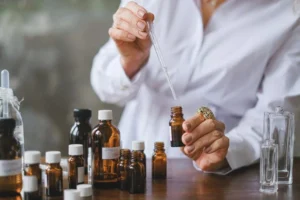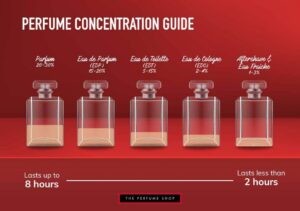Products News
The 5 Different Level Of Perfume and Explained Each One
You’ve probably noticed the letters “EDT,” “EDP,” or “Extrait de Parfum” inscribed on perfume bottles, but what do they truly mean Fragrance concentrations have a significant impact on both performance and the overall character of the scent. In this article, we’ll go through all the Different Level Of Perfume concentrations in great detail and show you what you truly receive when you purchase a new scent.
The 5 Different Level Of Perfume
- Parfum – Concentration of perfume oils – 20-40%
- Eau de Parfum (EDP) – Concentration of perfume oils – 15-20%
- Eau de Toilette (EDT) – Concentration of perfume oils – 5-15%
- Eau de Cologne (EDC) – Concentration of perfume oils – 2-5%
- Eau Fraîche – Concentration of perfume oils – 1-3%
1. Parfum
Parfum is typically used to describe fragrances that are robust, powerful, and long-lasting. Parfum scents are extremely potent in terms of aroma and performance due to their 25–35% oil content and lower alcohol percentage.
That is a general rule, though, and it doesn’t always hold true for some scents, like Dior Sauvage Parfum, whose EDT and EDP stay longer than the Parfum version! Due to its potent makeup, some individuals find it a touch too harsh or vigorous, so they stick to EDP, which may last just as long but is more calming.

Since perfumes with Parfum concentration typically have an extremely potent scent, I would advise wearing them on occasions when you don’t want your scent to get lost in a sea of other fragrances. Thanks to its potent concentration, Parfum will remain present even under the most trying circumstances.
2. Eau de Parfum (EDP)- The Second Different Level Of Perfume
Along with EDT, Eau de parfum, or EDP, has a 15–25% oil concentration and is one of the most widely used fragrance concentrations worldwide. EDP is often stronger in performance and aroma (stronger than EDT), however as the market develops, this isn’t always the case.
Of course, not every EDP smell will last for an absurdly long time; despite the concentration, the performance will also depend on the fragrance’s composition and quality. This implies that even if the oil content in two EDP smells is the same, they will behave differently.
EDP is really versatile; it has a strong, distinctive aroma that can be used in a variety of situations. Some of them are perfect for freezing, winter weather to warm you up, while others are more enjoyable for hot, summer days when you need a boost of freshness. Many EDP perfumes are so expertly matched that you may choose your favorite and wear it all year long. I would recommend EDP above other smells if you prefer to draw attention to yourself and receive plenty of praise.
3. Eau de Toilette (EDT)
One of the most common fragrance concentrations in Different Level Of Perfume is EDT, which typically indicates that the scent contains 5–15% essential oils. EDT is a good choice if you don’t mind refreshing a scent several times during the day for longer use.

Even though the general rule is that scents with EDT concentrations are not high-performing fragrances, Dior Sauvage is the primary example of a high-performing EDT. The extensive adaptability of EDT is another factor in people’s decisions. EDT smells are incredibly wearable and enticing for practically every event and season because of their light composition.
EDT often comes in bigger bottles because you will need to reapply it throughout the day and use more sprays, but on the plus side, they are also less expensive.
4. Eau de Cologne (EDC)
Looking for a light, energizing fragrance for the warmer, sunnier weather? Look for EDC concentration after that. EDC perfumes often last up to three hours but have a weaker, lighter aroma due to the low oil content (2–4% of essential oil) and higher amount of alcohol. They are occasionally referred to as sprays and are less expensive than Eau de toilette.
It’s a perfume you wear for a quick springtime stroll around the park or for a laid-back day of activities when you don’t need to smell alluring or remarkable. If you want to wear EDC, be ready to reapply it many times during the course of the day in order to maintain the smell.
Eau de cologne is not appropriate for any nighttime activity, notably partying or a formal function when you want to scent assertive and draw attention to yourself. But it’s fantastic for a stroll in the park.
5. Eau Fraiche
The last Different Level Of Perfume is Eau Fraiche, like Eau de cologne, which has a very low fragrance oil content (1-3%), but unlike Eau de cologne, it doesn’t include alcohol. In essence, Eau Fraiche is a diluted mixture of fragrance oil and water.

Since they don’t include alcohol, they are less aggressive than EDC but still fragrant. They only last for around two hours. They make excellent reviving smells, and daytime scents for casual activities, and Eau Fraiche is definitely a better option if you have sensitive skin than EDC if you don’t.
The notion for Eau Fraiche was initially developed by the Calvin Klein brand; the CK One had a musky smell with a citric and woodsy impact that many males liked. After that, several fashion brands copied Calvin Klein and began creating their own Eau Fraiche.
Conclusion:
It’s fair that consumers would become perplexed about a Different Level Of Perfume given the various variants of scents that are currently available for purchase. The intensity of a specific perfume is indicated by its aroma concentration. The more pure the scent is, the more expensive it is since it includes more perfume oils and less alcohol at a certain concentration.


